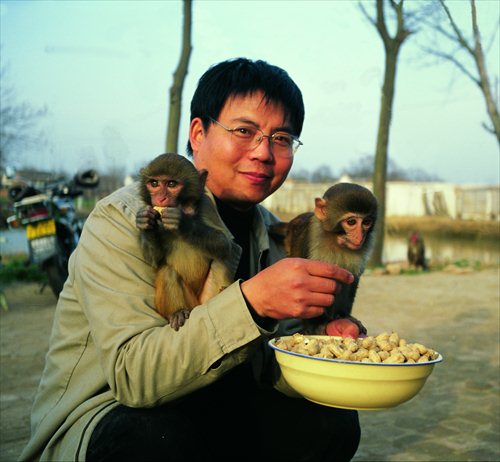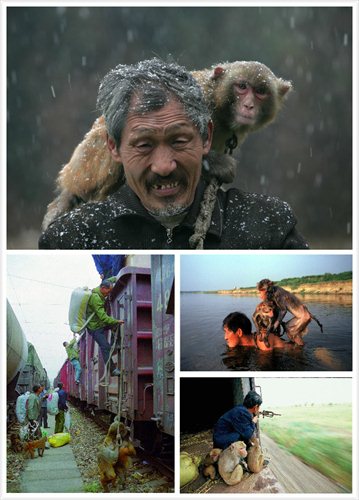Monkey men
Photography exhibition takes a look into the unseen lives of primate trainers
A new exhibition in Shanghai, titled Monkey Pilgrim, puts on display a series of portraits of monkey trainers by photographer Ma Hongjie (pictured below).

In one photo, a middle-aged monkey trainer appears standing in the dim sunset in a disused cornfield with his monkey before him. The monkey wears a tailored Chinese opera mask and a costume.
In another, the trainers appear walking along a country road in twos and threes, carrying huge backpacks with monkeys on their shoulders.
These photos introduce us to the unseen world of monkey trainers. To photograph this complicated but close relationship between man and monkey, veteran photographer and photo editor of the Chinese National Geography magazine Ma spent over a decade following the trainers from their villages to big cities.
In June 2001 Ma was taking photos on the streets of Luoyang, Henan Province where he spotted three monkey trainers. He became interested in the group and came to know that they came from Xinye county, a place known for its long history of monkey training.
This encounter led him to Xinye county to photograph monkey trainers.
It is a tradition in Xinye that when villagers have finished with the farm work every June and October, they go out and perform monkey tricks. They use the earnings to build new houses, to purchase farm tools and send their kids to school.
Ma said that according to the incomplete statistics of Xinye county, there were at least 2,000 monkey trainers who would go out and perform in 2002.
Like migrant workers, they go to the warm southern areas in winter and the cool northern areas in summer. Some older monkey trainers have even performed abroad.
After an unremitting search, Ma was introduced to many monkey trainers including the then 46-year-old Yang Lingui (below), who had been training monkeys for 17 years.

Yang Lingui is one of the many monkey trainers that the Chinese National Geography magazine photographer Ma Hongjie has been tracking and photographing for some 12 years. Photos: Courtesy of the photographer
Journey of hardship
There is an auspicious day for monkey trainers to set out, which falls on the third, sixth and the ninth day of the month according to the lunar calendar.
Knowing that Yang and his fellows were leaving for Northeast China, Ma decided to follow them. He didn't expect at that time that he would be tracking them for 12 years.
Yang's troupe includes his son, his brother, his friend and his nephew. There is a clear division of work for each member. One performs with the monkey, one collects money, one cooks and does the chores, while Yang is in overall charge.
Yang's monkeys include a male performing monkey, his female mate, a baby and a young trainee. If there were no female monkey in the troupe, the male wouldn't perform well.
The journey is a hard and dangerous one. Transportation, accommodation and food are all stumbling blocks to the monkey trainers.
To save money on transportation, instead of purchasing train tickets, the troupe would stow away on freight trains (above left).
In the cold, long nights on the train they have to play hide-and-seek with the railroad police, avoid being crushed by falling cargo, and run the risk of being locked in the train car by accident.
Many monkey trainers have lost arms, legs and even their lives in this way.
A bucket of tap water and some steam buns Yang brought from his village is all that Ma and Yang's troupe have on the train.
"I felt my heart pounding when I did it for the first time. It is very dangerous. Of course, I was very worried about it. Nobody knows what might happen on the train. When I told Yang that I would ride the train with them, he didn't believe I could face this hardship," Ma told the Global Times.
Some nights they had to sleep under a bridge. They would let Ma sleep in the middle of the group to protect him and his camera.
Show time
During their performances, the trainers threaten to whip the monkeys while the monkeys pretend to fight back. The arranged fighting scene between man and monkey attracts applause and cheers from onlookers.
When they collect money from the audience who have already formed a circle around them, they start from the outer ranks so the audience won't scatter.
However, it is totally up to the audience members whether they are willing to pay. Sometimes, the performers are looked down upon and scolded for abusing the monkeys.
The trainers also don't earn very much.
"Usually they are on the road for about three months and each of them can take back roughly 4,000 yuan ($607.32), which is a middling income in their hometown," said Ma.
Because of the low status and income of monkey training, the next generation is not interested in inheriting this tradition.
Ma said there are still over 1,000 monkey trainers in Xinye county, but the number has been steadily decreasing since he started his project.
"I spoke with the sons of some monkey trainers, and they told me that they don't want to follow this career," said Ma. "They find it indecent. Yang's son wouldn't even let me photograph him with his father. He wishes to find a job in the south, and Yang agrees."
Ma compiled his experience with the monkey trainers into a book named The Last Monkey Trainers in which he said "the history of monkey trainers is doomed to end with their generation."